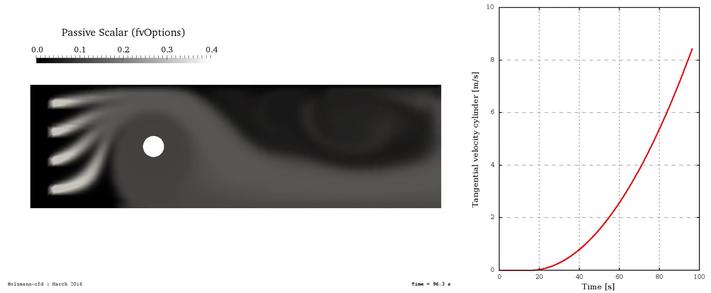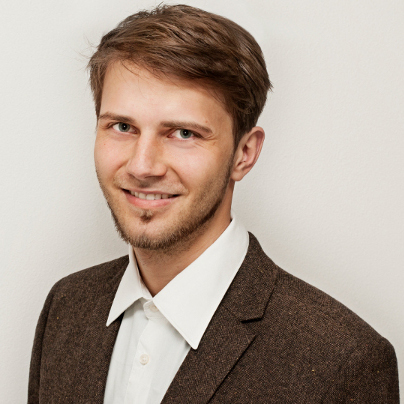Magnus Effect
2D meshing, pimpleFoam, codedFixedValue boundary condition
Tobias likes to transfer his thoughts into a numerical test case. The following example shows the Magnus effect, probably known from soccer. However, the Magnus effect occurs in many sports activities. Preferable if some object is rotating while moving along a trajectory.
The white stripes in the pictures below can be added using function objects and the fvOptions capability of OpenFOAM®
A 2D case is generated by using snappyHexMesh and other OpenFOAM® applications. The cylinder inside the fluid domain starts to rotate after 15 s. Due to the rotation, the fluid close to the wall will accelerate around the cylinder based on friction forces. The faster the cylinder wall turns, the more momentum is transported into the fluid domain. This force influences the path of the fluid going around. However, in reality, it is commonly vice-versa, and the object that follows a trajectory (while it is rotating) deviates, e.g., a football. The passive scalar (cf. video) was modeled by using the function object functionality. However, this was removed during a re-ordering of the case. An interesting effect occurs in that example. The Von Kárman vortex shedding streets occurs right at the beginning.



Published under the GNU General Public License 3
Over the last ten years, Tobias tried to publish a wide range of different materials related to OpenFOAM® and CFD. You know it much better than he does if the content is worth to be supported. If you want to thank Tobias for the work he did, feel free to tell the community your opinion about the work Tobias Holzmann is doing or you can email your thoughts directly to »
Support the work of Tobias Holzmann
The available OpenFOAM® training cases are tested and built for different OpenFOAM® versions (not distributions) on a Linux machine. During the tests, only the OpenFOAM Foundation version of OpenFOAM® was used. Furthermore, the following software packages are required for most of the training cases: Salome®, ParaView®, and for optimization tasks, one also needs the open-source software DAKOTA®. The OpenFOAM® cases might work with the ESI version of OpenFOAM® but it is not supported. For the OpenFOAM® extend project, the training cases will probably not work as the code diverged too much. Additionally, there is no support for Windows-based and MAC-based OpenFOAM® versions.
This offering is not approved or endorsed by OpenCFD Limited, producer and distributor of the OpenFOAM software via www.openfoam.com, and owner of the OPENFOAM® and OpenCFD® trade marks
Share the work on Your social network
Tobias would be grateful if you share his work on your social network in order to keep the OpenFOAM® community up to date. Furthermore, sharing the work will avoid that people investigate into topics, that are already prepared for your study such as the examples provided by Tobias Holzmann.


